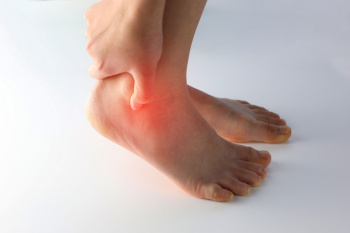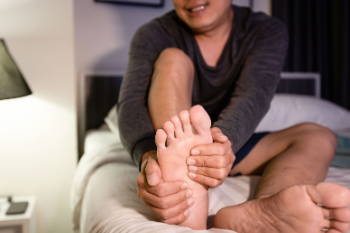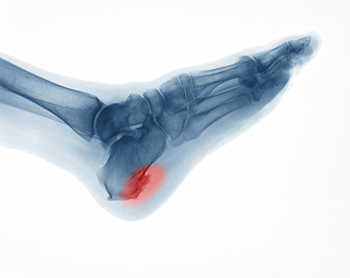
Chronic ankle instability, or CAI, is a condition where the ankle frequently gives way, often following repeated sprains. It affects those who have had previous ankle injuries, particularly athletes or individuals engaging in high-impact activities. Women, people with hypermobile joints, and those with improper rehabilitation after an initial injury are at higher risk. The causes of CAI are complex and difficult to pinpoint, involving a combination of mechanical instability from loosened ligaments and neuromuscular factors, like impaired balance and body awareness. Repeated injuries can lead to muscle weakness and poor joint control, further contributing to instability. While strength training is often recommended, research on its effectiveness in preventing or treating CAI remains inconclusive. If you have chronic ankle instability, it is suggested that you consult a podiatrist for a comprehensive treatment plan.
Ankle pain can be caused by a number of problems and may be potentially serious. If you have ankle pain, consult with one of our podiatrists from McKinney Podiatric Associates, PA. Our doctors will assess your condition and provide you with quality foot and ankle treatment.
Ankle pain is any condition that causes pain in the ankle. Due to the fact that the ankle consists of tendons, muscles, bones, and ligaments, ankle pain can come from a number of different conditions.
Causes
The most common causes of ankle pain include:
Symptoms
Symptoms of ankle injury vary based upon the condition. Pain may include general pain and discomfort, swelling, aching, redness, bruising, burning or stabbing sensations, and/or loss of sensation.
Diagnosis
Due to the wide variety of potential causes of ankle pain, podiatrists will utilize a number of different methods to properly diagnose ankle pain. This can include asking for personal and family medical histories and of any recent injuries. Further diagnosis may include sensation tests, a physical examination, and potentially x-rays or other imaging tests.
Treatment
Just as the range of causes varies widely, so do treatments. Some more common treatments are rest, ice packs, keeping pressure off the foot, orthotics and braces, medication for inflammation and pain, and surgery.
If you have any questions, please feel free to contact one of our offices located in Pasadena, Baytown, League City, Houston, and Pearland,TX . We offer the newest diagnostic and treatment technologies for all your foot care needs.

Three common causes of foot pain are plantar fasciitis, arthritis, and tendonitis. Plantar fasciitis is caused by inflammation of the tissue along the bottom of the foot, leading to sharp heel pain, especially after periods of rest. Diagnosis is usually based on symptoms and physical examination. Arthritis, particularly osteoarthritis, causes joint pain and stiffness, often affecting older adults or individuals with prior injuries. X-rays can help diagnose arthritis by showing joint damage. Tendonitis is inflammation of tendons, such as the Achilles, often from overuse or poor footwear. Diagnosis involves a physical exam and imaging. Treatment for foot pain includes custom orthotics as well as prescribed medication for pain. If you are suffering with persistent or worsening foot pain, it is suggested that you visit a podiatrist for appropriate treatment.
Foot Pain
Foot pain can be extremely painful and debilitating. If you have a foot pain, consult with one of our podiatrists from McKinney Podiatric Associates, PA. Our doctors will assess your condition and provide you with quality foot and ankle treatment.
Causes
Foot pain is a very broad condition that could be caused by one or more ailments. The most common include:
Diagnosis
To figure out the cause of foot pain, podiatrists utilize several different methods. This can range from simple visual inspections and sensation tests to X-rays and MRI scans. Prior medical history, family medical history, and any recent physical traumatic events will all be taken into consideration for a proper diagnosis.
Treatment
Treatment depends upon the cause of the foot pain. Whether it is resting, staying off the foot, or having surgery; podiatrists have a number of treatment options available for foot pain.
If you have any questions, please feel free to contact one of our offices located in Pasadena, Baytown, League City, Houston, and Pearland,TX . We offer the newest diagnostic and treatment technologies for all your foot care needs.

Plantar fasciitis is a common foot condition that causes heel pain, often most noticeable with the first steps in the morning. It occurs when the thick band of tissue connecting the heel bone to the toes becomes inflamed due to overuse, strain, or repetitive impact. Common in runners, individuals who stand for long periods, and those with flat feet or high arches, plantar fasciitis can cause sharp, stabbing pain in the heel or arch, especially after rest or prolonged activity. Relief focuses on reducing inflammation and relieving stress on the fascia. This can be achieved by resting and wearing supportive footwear or orthotic inserts. Anti-inflammatory medications and targeted stretching exercises may also be prescribed. In more severe cases, corticosteroid injections or, rarely, surgery may be needed to alleviate symptoms and promote healing. If you have persistent heel and arch pain, it is suggested that you schedule an appointment with a podiatrist for a proper diagnosis and relief options.
Plantar fasciitis is a common foot condition that is often caused by a strain injury. If you are experiencing heel pain or symptoms of plantar fasciitis, contact one of our podiatrists from McKinney Podiatric Associates, PA. Our doctors can provide the care you need to keep you pain-free and on your feet.
What Is Plantar Fasciitis?
Plantar fasciitis is one of the most common causes of heel pain. The plantar fascia is a ligament that connects your heel to the front of your foot. When this ligament becomes inflamed, plantar fasciitis is the result. If you have plantar fasciitis you will have a stabbing pain that usually occurs with your first steps in the morning. As the day progresses and you walk around more, this pain will start to disappear, but it will return after long periods of standing or sitting.
What Causes Plantar Fasciitis?
There are some risk factors that may make you more likely to develop plantar fasciitis compared to others. The condition most commonly affects adults between the ages of 40 and 60. It also tends to affect people who are obese because the extra pounds result in extra stress being placed on the plantar fascia.
Prevention
There are a variety of treatment options available for plantar fasciitis along with the pain that accompanies it. Additionally, physical therapy is a very important component in the treatment process. It is important that you meet with your podiatrist to determine which treatment option is best for you.
If you have any questions, please feel free to contact one of our offices located in Pasadena, Baytown, League City, Houston, and Pearland,TX . We offer the newest diagnostic and treatment technologies for all your foot care needs.

Bone spurs, or osteophytes, are bony growths that can develop on the heel due to excessive stress, injury, or conditions like plantar fasciitis. These spurs typically form where tendons and ligaments attach to the bone, causing localized pain and discomfort. Symptoms of heel bone spurs include sharp or aching pain, especially with the first steps in the morning or after prolonged periods of rest. Swelling and inflammation surrounding the heel may also be present. Relief often involves a combination of approaches to alleviate pain and reduce inflammation. This can include wearing supportive footwear, using custom orthotics, and resting the affected area. Stretching exercises may also be beneficial. In more severe cases, corticosteroid injections or surgery might be necessary. To address heel pain and explore effective treatments, it is suggested you schedule an appointment with a podiatrist who can provide tailored care for your condition.
Heel spurs can be incredibly painful and sometimes may make you unable to participate in physical activities. To get medical care for your heel spurs, contact one of our podiatrists from McKinney Podiatric Associates, PA. Our doctors will do everything possible to treat your condition.
Heels Spurs
Heel spurs are formed by calcium deposits on the back of the foot where the heel is. This can also be caused by small fragments of bone breaking off one section of the foot, attaching onto the back of the foot. Heel spurs can also be bone growth on the back of the foot and may grow in the direction of the arch of the foot.
Older individuals usually suffer from heel spurs and pain sometimes intensifies with age. One of the main condition's spurs are related to is plantar fasciitis.
Pain
The pain associated with spurs is often because of weight placed on the feet. When someone is walking, their entire weight is concentrated on the feet. Bone spurs then have the tendency to affect other bones and tissues around the foot. As the pain continues, the feet will become tender and sensitive over time.
Treatments
There are many ways to treat heel spurs. If one is suffering from heel spurs in conjunction with pain, there are several methods for healing. Medication, surgery, and herbal care are some options.
If you have any questions feel free to contact one of our offices located in Pasadena, Baytown, League City, Houston, and Pearland,TX . We offer the latest in diagnostic and treatment technology to meet your needs.

A bunion is a bony bump that forms at the base of the big toe, where it meets the long bone of the foot. Bunions develop when the big toe pushes towards the second toe, causing the joint at the base of the big toe to protrude. This misalignment is often made worse by wearing tight or ill-fitting shoes, particularly those with high heels or a narrow toe box. Symptoms of bunions include pain, swelling, and redness surrounding the affected joint, and difficulty finding comfortable footwear. Over time, the misalignment can worsen, making daily activities uncomfortable. Treatment for bunions focuses on alleviating pain and preventing further progression. A podiatrist can discuss options that may include wearing wider, more supportive shoes, using orthotic devices to correct foot alignment, and performing exercises to improve joint mobility. In persistent cases, surgery may be considered. If you have developed a bunion, it is suggested you schedule an appointment with a podiatrist for a treatment plan.
If you are suffering from bunion pain, contact one of our podiatrists of McKinney Podiatric Associates, PA. Our doctors can provide the care you need to keep you pain-free and on your feet.
What Is a Bunion?
Bunions are painful bony bumps that usually develop on the inside of the foot at the joint of the big toe. As the deformity increases over time, it may become painful to walk and wear shoes. Women are more likely to exacerbate existing bunions since they often wear tight, narrow shoes that shift their toes together. Bunion pain can be relieved by wearing wider shoes with enough room for the toes.
Causes
Symptoms
In order to diagnose your bunion, your podiatrist may ask about your medical history, symptoms, and general health. Your doctor might also order an x-ray to take a closer look at your feet. Nonsurgical treatment options include orthotics, padding, icing, changes in footwear, and medication. If nonsurgical treatments don’t alleviate your bunion pain, surgery may be necessary.
If you have any questions, please feel free to contact one of our offices located in Pasadena, Baytown, League City, Houston, and Pearland,TX . We offer the newest diagnostic and treatment technologies for all your foot care needs.